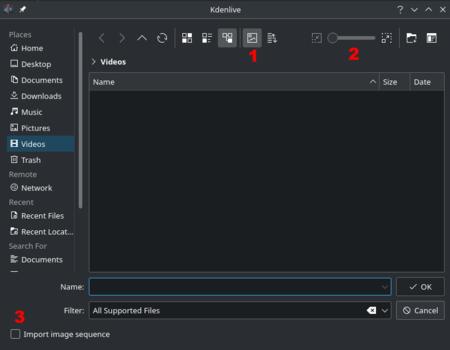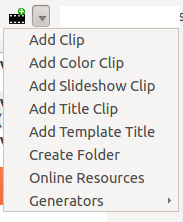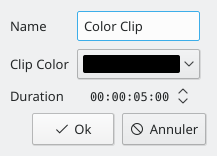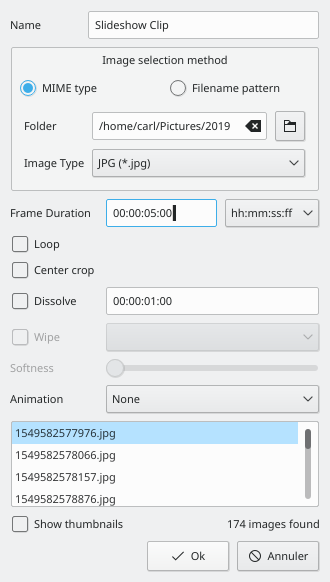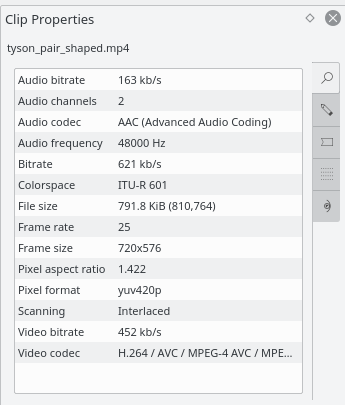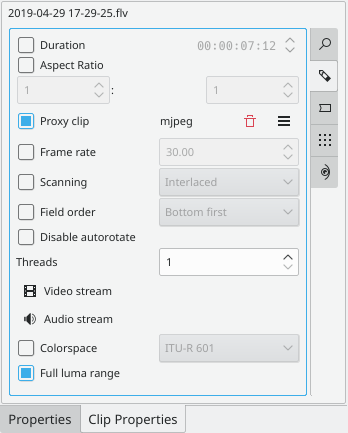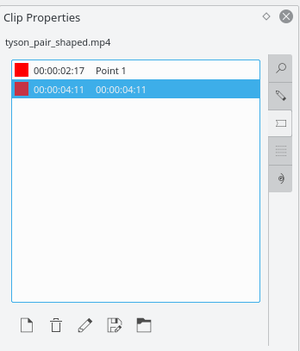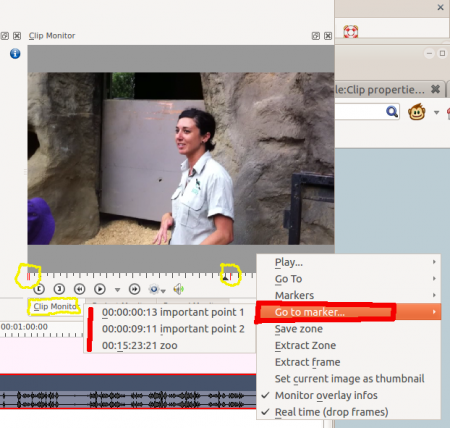Archive:Kdenlive/Manual/Projects and Files/Clips
Clips (Video, Audio and Images)
The ![]() button (Add Clip) brings up the Add Clip Dialog where you can choose video, audio or still image clips to add to the project tree.
button (Add Clip) brings up the Add Clip Dialog where you can choose video, audio or still image clips to add to the project tree.
The button ![]() labeled 1 toggles File Preview on and off. The slider labeled 2 adjusts the size of the preview icons. The checkbox labeled 3 enables the import of a series of images that can be used to make a stop motion animation. The checkbox labeled 4 - is for ???
labeled 1 toggles File Preview on and off. The slider labeled 2 adjusts the size of the preview icons. The checkbox labeled 3 enables the import of a series of images that can be used to make a stop motion animation. The checkbox labeled 4 - is for ???
You can add other types of clips by choosing a clip type from the menu brought up from the drop down button next to the ![]() button.
button.
Color clips
Color clips are images of a single color that can be added to the project tree. They can be useful to provide a background on which to place titles.
Add color clips by choosing from the drop down button next to the ![]() button.
button.
This brings up the Color clip dialog from which you can choose a color and a duration.
Clicking adds the clip to the project tree. The clip can then be dragged to the time line. The duration of the color clip can be adjusted on the timeline.
Title clips
See Titles
Slideshow clips
Slideshow clips are clips created from a series of still images. The feature can be used to make an animation from a collection of still images or to create a slideshow of still images. To create the former - use a short frame duration and to create the latter use a long frame duration.
To create a slide show clip choose from the drop down list.
From the Slideshow clip dialog choose as Image selection method.
Browse to the location of the images that go to make up your slideshow and select the first image that will make up the slideshow. The subsequent images that are to be used in the slide show will be selected based on some sort of filename algorithm that predicts what the next image file name should be.
For example if the first image is 100_1697.jpg then the next will be 100_1698.jpg, etc.
Select an appropriate frame duration - this defines how long each image will appear for.
Then hit . A video file made up of all the images in the folder from where you selected the first frame file from will be added to the project tree.
You can then drag this video to the timeline.
Stop Motion
Proxy clips
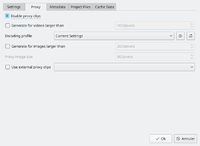
Proxy clips are one of the most useful inventions for editing if you are not working on a ultra high-end machine. The trick is that the original clips are replaced by clips with lower resolution clips, with a less complex codec. Video decoding, e.g. of H.264 clips, requires a lot of computing power, but computing power is required for rendering effects in real-time. If insufficient is available, replay will stutter. Proxy clips will require hardly any computing power at all, which allows fluent replay.
Proxy clips can be enabled / disabled for the current project in the Project Settings ().
To enable proxy clips by default for new projects, go to . See also Project Settings page
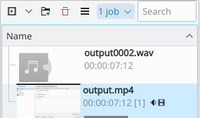
As soon as proxy clips are enabled, they can be generated for specific project clips in the Project Tree widget via the context menu . After you select for a clip a job will start to create a proxy clip. You can tell the progress of this job by looking at the little gray progress bar that appears at the bottom of the clip in the Project Tree - see picture. Clicking again disables the proxy for this clip.

Once the proxy clip creation has completed the proxy clip will appear with a P icon in the Project Tree.
When rendering to the output file, you can choose whether to use the proxy clips as well. It is by default disabled, but for a quick rendering preview it is useful.
Clip Properties
You can display and edit clip properties by selecting a clip in the project tree and choosing from the menu or from the right-click menu.
Video Properties
Advanced Properties
The tab displays... well ... the advanced properties of the clip. You can edit the advanced properties here. For example you can use Force aspect ratio to tell a clip that seems to have forgotten it was 16:9 ratio that it really is 16:9 ratio.
See Full Luma range for details on what this setting means
Markers
You can use the tab to add markers for certain points in the source file that are important.
Once markers are put in your clip you can access them in the clip monitor by right clicking and selecting (see picture.) Also note how the markers appear as red vertical lines in the clip monitor (see yellow highlighted regions in the picture.)


